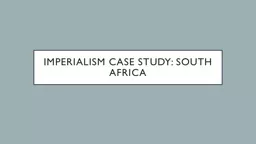

What do these signs appear to say Where do you think they are from Three groups clash over south africa Africans the Dutch and the British clashed over land and resources in South Africa ID: 816483
Download The PPT/PDF document "Imperialism case study: South Africa" is the property of its rightful owner. Permission is granted to download and print the materials on this web site for personal, non-commercial use only, and to display it on your personal computer provided you do not modify the materials and that you retain all copyright notices contained in the materials. By downloading content from our website, you accept the terms of this agreement.
Slide1
Imperialism case study: South Africa
Slide2What do these signs appear to say?
Where do you think they are from?
Slide3Three groups clash over south africa
Africans, the
Dutch
, and the British clashed over land and resources in South Africa
The Europeans viewed the land as largely
unoccupied
, but local ethnic groups had been disputing over the lad for over 100 years
Slide4Zulus fight the British
In 1816, Zulu chief
Shaka
used highly skilled warriors to create a strong centralized Zulu state
His successors, however, struggled to keep the state strong under the threat of European invaders. These invaders had superior weapons like
guns.
In 1879, the Zulus, ruled by king
Cestshwayo
, were defeated in the
Battle of Ulundi
.
The Zulu nation fell to British control in 1887.
Slide5Boers and British settle in the cape
The
Dutch
came to settle the Cape of Good Hope in 1652. They established a trade route here between the Netherlands and the Dutch East Indies.
The
Boers
(Dutch farmers, also known as the
Afrikaners
) took African land and established large farms.
The Boers and the British clashed over land and slaves in the area after the British took over the Cape colony in the 1800s.
Slide6Boers and British settle in the cape
The Boers moved North to escape British rule in the 1830s in a migration called the
“Great Trek”
In the North, they had confrontations with the Zulus and other African ethnic groups because they began taking their land
Slide7The Boer war
Diamonds and Gold were discovered in Southern Africa in the 1860s and 1880s.
The Boers tried to keep “outsiders” from coming in to mine the lands by denying them
political
rights
An attempt to start a rebellion against the Boers failed, and the Boers blamed the British and took up arms with them in 1899
The Boer War
or South African War, was the first example of modern “total war”
The Boers used
guerilla tactics
against the British and the British burned Boer farmlands and imprisoned women and children in concentration camps.
Slide8Boer war
Black South Africans were also involved in this war. They served as scouts, guards, drivers, and workers.
Over
14,000
Black South Africans died after being captured by the British and sent to
concentration
camps.
Britain won the war in 1910, and the Boer republics were joined into a self-governing Union of South Africa which was controlled by the British
Slide9Boer war
The establishment of colonies, marked a change in way of life for the South Africans
The Europeans made efforts to change the
political,
social, and economic
lives of the people they conquered
Boer War
Slide10Homework
Read
pg
609 in the textbook answer the following:
What was Apartheid and what/who caused it?
Who
was Nelson Mandela, and what was his role in ending
Apartheid?
Slide11South Africa day 2
Slide12Do Now
Link
Apartheid
- A system
of institutionalized
racial segregation and discrimination in South Africa between 1948 and 1991.
Slide13Primary Source analysis
With group members, read
The Freedom Charter
Work together to answer the questions that accompany the document
Slide14System of Apartheid
Read the
Apartheid
History.com
packet and answer the following:
When did the system of apartheid begin? What policy enacted in 1913 set up the system of segregation in South Africa?
How did the
Great Depression and World War II
play a role in apartheid? What was the goal of separating the black South Africans along tribal lines?
Read the section entitled “Apartheid becomes law” and name
two
restrictions placed upon “non-white” groups under apartheid
Explain the idea of “Separate Development”
What happened to land owned by Black South Africans in 1961-1994?
Name one way that South Africans resisted/protested apartheid
What happened in Sharpsville in 1960?
How did the UN respond to apartheid in 1973 and 1976? How did the United Kingdom and Unite
dStates
react?
What year did apartheid end? What changes were made to the government in South Africa?
Slide15Optional Extra Credit Assignment
MUST be turned in on Monday 4/24/17
MUST be your own work, done independently, using information from the notes and study guide
If successfully completed
ON TIME
, you can earn
HALF
of your lost points back
Assignment: Answer the following questions in
THREE PARAGRAPHS OR MORE:
What is Imperialism? What were the different motives Europeans had for Imperialism? How did Imperialism effect life for the people living in the Congo Free State?
Slide16South Africa day 3
What we are doing:
Complete “Do Now” primary source analysis
Apartheid notes
Nelson Mandela video clip and discussion
HW: Nelson Mandela Primary Source Analysis worksheet